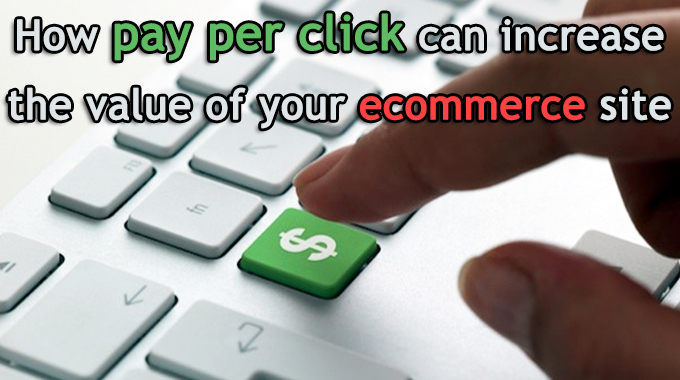How pay per click can increase the value of your ecommerce site

When it comes to generating traffic for your ecommerce site, you have multiple options: content, SEO, social, email, forums, webinars and many other possible sources. But when you have a well-optimized ad, there are few traffic sources as valuable as pay per click, or PPC.
PPC is a paid advertising model that allows you to send direct traffic to your website. It can also help your site be seen in search, as PPC ads tend to be displayed toward the top of search results.
As a result, you’ll get more eyeballs on your product offering. Not everyone who visits your site will necessarily buy, of course, but you can optimize conversions by testing and experimenting with different copy, designs, colors, offers, keywords and so forth.
Converting the traffic you get is the hard part, but targeting your content is getting easier than ever; and dynamic search ads could well be a game-changer in this regard.
So, if you’re curious how PPC can increase the value of your ecommerce site over the long haul, consider the following categories:
Diversified traffic and revenue sources
In an online business valuation, prospective buyers are going to be taking a close look at the various revenue sources your site has. And, the fewer revenue channels you have, and the more dependent you are on any one traffic model, the more at risk your site may be. That means a risk of losing revenue.
For example, say that search is your No. 1 traffic source. Because of ongoing search engine algorithm updates, your site could suddenly become de-ranked in search by the latest update. That’s not rare, since search engines can — and often do — change the game. So, remaining reliant on search alone could definitely have some downsides.
If you have diversified revenue streams, though, buyers will value your site higher. Even if your site is at risk of losing one source of revenue, the existence of backup sources will allow your business to be valued more, and will give it more longevity.
If you haven’t yet added PPC to your promotional efforts, now may be a good time to look into it for your business.
Sales and conversion stats
One of the great things about PPC ads is that tracking occurs automatically. After you run an ad campaign, you’ll be able to log into your account and view all relevant stats to see how your ads performed.
This allows you to nail down your cost-per-acquisition and conversion rate. Prospective buyers are very likely interested in these numbers since they’ll want to get a better idea of the expenses involved in driving revenue.
Generally, the lower the expenses are in relation to revenue, the better. This is where conversion-rate optimization comes in, and you may have to do a significant amount of testing to figure out how to get more sales. Because of how good targeting is becoming, however, this could be a moot point. More on that in a moment.
Bottom line: Buyers will want to see numbers related to acquisition and conversion to better understand whether or not their investment is worthwhile. The data you collect will prove invaluable to the sales process.
The ability to target better
On first inspection, PPC may appear to be a shotgun approach to advertising — a means for pushing your ads in front of anyone that searches for a specific keyword. No wonder conversion rates tend to be so low.
But in Google AdWords, for instance, you can actually upload your customer email list. As you get more sales and collect more customer data, you can refine your targeting by importing this data directly into your PPC platform.
You can therefore target the people who have already bought, but also target similar, look-alike audiences. Such “re-marketing” is an incredibly effective way of generating more lifetime value from your customers, something an investor would surely like to see.
Additionally, dynamic search ads are also increasing in prominence. They allow you to show your ads based on the content of your website, not just on specific keywords of your choosing. This can actually eliminate the need for keyword lists and even landing pages, and can also boost your ROI.
Finally, the better defined your audience is, the better idea buyers are going to have of how to market your products to drive sales when they buy your business.
Audience targeting with PPC is only going to continue to improve over the long haul, so it’s better to be a part of the wave than to be left behind.
Integration with other channels
We’ve already looked at how you can leverage your email and customer list for targeting and remarketing purposes. This is just one example of how instances of integration between different channels and platforms are going to proliferate.
Social media is the perfect example. Popular sites like Facebook and Twitter are only going to grow in importance as pertains to audience-building and targeting. Ignoring social could mean leaving a lot of opportunity on the table.
Further integration with customer-relationship management tools should also be forthcoming. Customization is not lost on PPC platforms. The value of sending personalized marketing messages and providing a tailored customer experience has been known for a while, but it won’t be long before businesses and marketers can do more to appeal to their customers with their ads. Dynamic search ads are just one example of this notion in motion.
It’s safe to say, then, that PPC ads are here to stay, and the technology will continue to improve. A well-educated investor keeping up with the trends is sure to look upon your use of PPC advertising in a positive light.
Conclusion
Investors looking at online businesses for sale aren’t just looking for one thing, and the big-picture merits and demerits of a business are often specific to that business. What might be considered favorable in one situation won’t necessarily be a benefit in another.
But most ecommerce business owners would do well to look into PPC and the opportunities it can offer them. For owners who want to eventually sell their business for more, PPC is a particularly essential step.
___
by THOMAS SMALE

